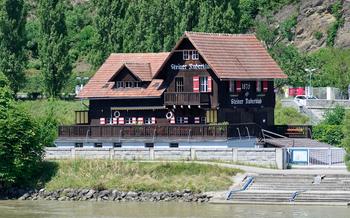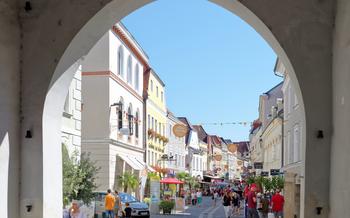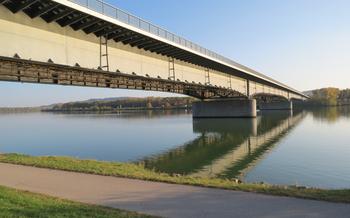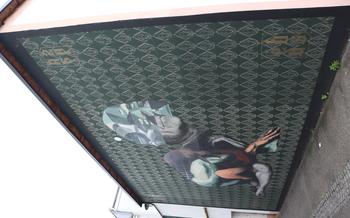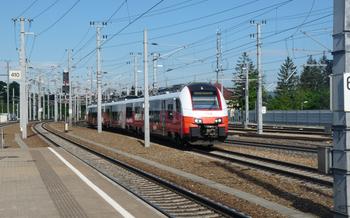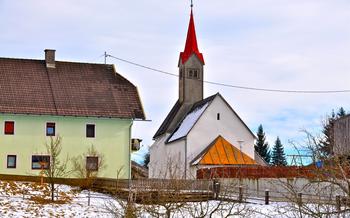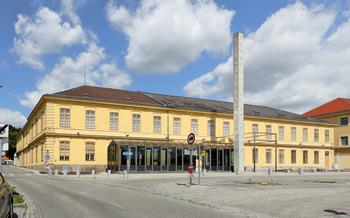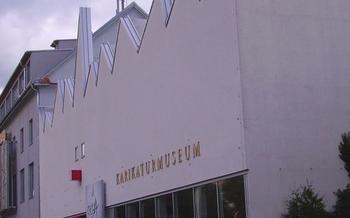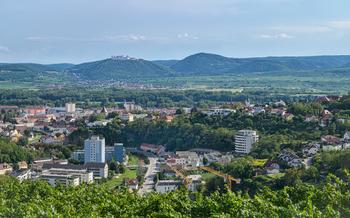
Dominikanerkirche
- History of the Dominikanerkirche
- Location and Accessibility:
- Exterior Architecture:
- Interior Architecture:
- Altarpiece and Sculptures
- Frescoes and Murals
- Stained Glass Windows
- Organ and Music
- Historical and Cultural Significance
- Guided Tours and Events
- Photography and Filming
- Dress Code and Etiquette
- Accessibility for Visitors with Disabilities
- Nearby Attractions and Activities
- Insider Tip:
History of the Dominikanerkirche
The Dominikanerkirche, also known as the Church of the Dominicans, is a stunning Gothic masterpiece in the heart of Krems an der Donau, Austria. Its history is intertwined with the rise of the Dominican Order and the rich cultural heritage of the city. Founded in 1227 by the Dominican friars, the church was initially a modest structure. However, in the 14th century, it underwent significant expansion and reconstruction, transforming it into the magnificent edifice we see today. The Dominikanerkirche exemplifies the architectural prowess of the Gothic period, blending traditional Romanesque elements with intricate Gothic details. Over the centuries, the church has witnessed numerous historical events, serving as a place of worship, a center of religious learning, and a symbol of the city's enduring spirit. Today, it stands as a testament to the enduring power of faith and the artistic legacy of the Dominican Order.
Location and Accessibility:
The Dominikanerkirche is conveniently located in the heart of Krems an der Donau, a charming city situated along the Danube River in Lower Austria. Its exact address is Dominikanerplatz 1, 3500 Krems an der Donau. Reaching the church is a breeze, whether you choose to explore the city on foot, by bicycle, or using public transportation. For those arriving by car, there are several parking options nearby, including the Donauparkplatz and the Parkgarage am Steinertor. The church stands proudly in the historic center of Krems, surrounded by cobblestone streets, quaint cafes, and boutiques, making it easy to combine a visit to the Dominikanerkirche with a delightful stroll through the city. The church's central location also ensures accessibility for visitors with disabilities, as the surrounding area is well-equipped with ramps and elevators.
Exterior Architecture:
Dominating the streets of Krems an der Donau, the Dominikanerkirche stands as a testament to the city's rich history. The church's exterior is a captivating blend of Romanesque and Gothic architectural styles, showcasing the transition from one era to another. The facade, with its intricate carvings and delicate ornamentation, is a masterpiece of craftsmanship and artistry.
The two towers, rising majestically on either side of the entrance, are adorned with intricate stonework and graceful spires that reach towards the sky. The buttresses, with their rhythmic strength, provide both structural support and a sense of visual harmony to the exterior. The use of local limestone, with its warm, earthy tones, adds a sense of authenticity and rootedness to the church's design.
The overall effect of the Dominikanerkirche's exterior is one of grandeur and elegance, inviting visitors to step inside and explore the architectural wonders that await within.
Interior Architecture:
The interior of the Dominikanerkirche is a testament to Gothic architectural mastery, characterized by its soaring vaulted ceilings, slender pillars, and graceful arches. The nave, the central aisle of the church, leads visitors towards the impressive high altar, drawing their eyes upward to the intricate rib vaults overhead. The side aisles, separated from the nave by rows of pillars, provide a sense of intimacy and offer views of the stunning stained glass windows that adorn the church's walls.
The transepts, which intersect the nave perpendicularly, create a cruciform layout, emphasizing the church's symbolic connection to Christianity. The choir, located at the eastern end of the church, is enclosed by an ornate rood screen, separating it from the main body of the nave. This area, reserved for the clergy during religious services, features elaborate carvings and decorative elements that enhance its significance.
Throughout the interior, visitors can admire the skillful artistry and attention to detail that went into the church's construction. The pillars, with their intricate capitals and moldings, support the weight of the vaulted ceilings, creating a sense of awe and grandeur. The arches, with their pointed shapes, guide the eye towards the heavens, reinforcing the spiritual nature of the space.
The overall design of the Dominikanerkirche's interior reflects the transition from Romanesque to Gothic architecture, blending the solidity of the former with the lightness and elegance of the latter. The harmonious interplay of architectural elements creates a serene and uplifting atmosphere, inviting visitors to contemplate the spiritual significance of this sacred space.
Altarpiece and Sculptures
The Dominikanerkirche boasts a stunning main altarpiece that serves as a focal point of the interior. Crafted from wood and adorned with intricate carvings, the altarpiece showcases a harmonious blend of Gothic and Renaissance styles. Its central panel depicts scenes from the life of Christ, while the surrounding panels feature sculptures of saints and biblical figures. Each figure is meticulously detailed, capturing the essence of their respective characters and conveying a sense of devotion and spirituality.
Among the notable sculptures found within the church are the statues of the Four Evangelists, which flank the main altarpiece. These life-size figures, carved from limestone, showcase the exceptional craftsmanship of the period. Their expressive faces and intricate drapery add to the overall grandeur and artistic value of the church's interior.
The symbolism and iconography represented in the altarpiece and sculptures play a crucial role in conveying religious narratives and theological concepts. The scenes depicted in the main altarpiece serve as a visual representation of the central tenets of Christianity, while the sculptures of saints and biblical figures act as reminders of the importance of faith, devotion, and the power of intercession. Together, these artworks create a rich visual and spiritual experience that invites visitors to contemplate the deeper meanings behind the church's sacred spaces.
Frescoes and Murals
The Dominikanerkirche is adorned with stunning frescoes and murals that contribute to its rich visual beauty and spiritual atmosphere. The artwork within the church spans various artistic periods, showcasing the evolution of styles and techniques. Visitors can admire the vibrant and intricate frescoes adorning the walls and ceilings, depicting religious scenes and biblical narratives. These artworks bring to life stories from the Old and New Testaments, offering a captivating visual interpretation of Christian history.
Among the notable frescoes, the "Legend of Saint Dominic" stands out for its intricate storytelling and expressive figures. This series of paintings narrates the life and miracles of Saint Dominic, the founder of the Dominican Order. The vivid colors and dynamic compositions of these frescoes captivate viewers and invite them to delve deeper into the saint's remarkable journey.
In addition to the frescoes, the Dominikanerkirche also features impressive murals that grace its interior spaces. These murals often depict scenes from the life of Jesus Christ, such as the Nativity, the Crucifixion, and the Resurrection. The skillful use of light, shadow, and perspective in these murals creates a sense of depth and realism, drawing viewers into the sacred stories they portray.
The frescoes and murals within the Dominikanerkirche serve as a testament to the artistic prowess of past masters and their dedication to creating a visually stunning and spiritually uplifting environment. These artworks continue to inspire and captivate visitors, enhancing their experience of this historic church.
Stained Glass Windows
The Dominikanerkirche is adorned with exquisite stained glass windows that bathe the interior in a kaleidoscope of colors. These magnificent artworks depict scenes from the Bible, the lives of saints, and historical events. The windows were carefully crafted by skilled artisans using traditional techniques, and their vibrant hues have been meticulously preserved over the centuries.
As sunlight filters through the stained glass, it casts a warm, ethereal glow upon the church's interior. Each window tells a unique story, inviting viewers to contemplate the rich narratives and symbolism embedded within. The windows depict biblical figures with intricate details, capturing their emotions and expressions with remarkable precision.
Visitors can spend hours marveling at the beauty and artistry of the stained glass windows. They are a testament to the skill and dedication of the craftsmen who created them, and they continue to inspire awe and wonder in all who behold them.
Organ and Music
The Dominikanerkirche is renowned for its magnificent organ, crafted by the esteemed organ builder Franz Xaver Christoph in 174Its intricate design, adorned with ornate carvings and golden accents, complements the splendor of the church's interior. The organ boasts 25 stops, two manuals, and a pedal, creating a rich and harmonious sound that fills the sacred space.
Throughout history, the organ has accompanied countless religious ceremonies, masses, and festive occasions within the church. Its melodious notes have resonated through the centuries, enhancing the spiritual atmosphere and evoking a sense of awe and devotion among the faithful.
Beyond its liturgical role, the organ has also served as a platform for showcasing musical talent and cultural events. Renowned organists and musicians have graced the church with their performances, captivating audiences with their virtuosic skills and renditions of classical and sacred compositions.
The acoustics of the Dominikanerkirche, with its high vaulted ceilings and reverberant walls, contribute to the exceptional musical experience. The organ's harmonious tones reverberate throughout the space, creating a symphony that envelops listeners in a transcendent soundscape.
Historical and Cultural Significance
The Dominikanerkirche holds immense historical and cultural significance in Krems an der Donau. As a place of worship, it has been a spiritual center for the local community for centuries, witnessing countless religious ceremonies, prayers, and celebrations. Its role in shaping the city's identity is evident in its prominent position and its integration into the urban fabric.
The church has been associated with several notable events and figures throughout history. In 1451, Emperor Frederick III attended a mass at the Dominikanerkirche, marking a significant moment in the city's relationship with the Habsburg dynasty. The church also served as a venue for important political gatherings and meetings, reflecting its status as a hub of civic life.
In the 17th century, the Dominikanerkirche underwent a major renovation and expansion, resulting in the addition of the Baroque-style nave and side chapels. This architectural transformation not only enhanced the church's grandeur but also reflected the changing artistic and cultural trends of the time.
Today, the Dominikanerkirche stands as a protected historical monument, recognized for its architectural and cultural value. Ongoing preservation efforts ensure that this cherished landmark continues to captivate visitors with its rich history and enduring beauty.
Guided Tours and Events
The Dominikanerkirche offers guided tours for visitors who want to delve deeper into its history, architecture, and art. These tours are led by knowledgeable guides who provide insights into the church's construction, historical events, and unique features. Visitors will learn about the significance of the church's altarpiece, frescoes, and stained glass windows and gain a deeper appreciation for the symbolism and iconography represented within the church.
Guided tours typically cover the church's exterior and interior, highlighting notable architectural elements and discussing the church's role in the community throughout the centuries. Visitors will have the opportunity to ask questions and explore the church at their own pace, while gaining a comprehensive understanding of its cultural and historical significance.
In addition to guided tours, the Dominikanerkirche hosts various events and concerts throughout the year. These events include organ recitals, choral performances, and classical music concerts that showcase the church's exceptional acoustics. Visitors can check the church's website or inquire at the parish office for information on upcoming events and concert schedules.
Photography and Filming
Photography and filming inside the Dominikanerkirche are generally permitted for personal use, but certain guidelines and restrictions apply.
When taking photos or videos, visitors should be mindful of the sacred nature of the church and avoid any disruptive behavior. Using flash photography is not allowed, as it can damage the artwork and disturb other visitors. Tripods and selfie sticks are also not permitted inside the church.
For professional photography or filming projects, such as commercial shoots or documentaries, a permit must be obtained from the church authorities in advance. Fees may apply, and specific conditions may need to be met to ensure the preservation of the church's heritage and the privacy of its visitors.
To capture stunning photographs of the Dominikanerkirche, consider visiting during the golden hours of sunrise or sunset when the light casts a warm glow on the exterior and interior of the church. The church's intricate details and stained glass windows are best captured using a wide-angle lens.
Photography and filming should not interfere with religious services, guided tours, or other events taking place in the church. Visitors are encouraged to be respectful and considerate of other visitors and the church's staff.
Dress Code and Etiquette
When visiting the Dominikanerkirche, it is important to dress respectfully, as it is a sacred place of worship. While there is no strict dress code, visitors should avoid wearing shorts, tank tops, or revealing clothing. Modest attire that covers shoulders and knees is generally recommended. It is also important to be mindful of noise levels and avoid talking loudly or using mobile phones during services or quiet moments of reflection. Visitors should also be respectful of the church's religious significance and refrain from engaging in any disruptive or disrespectful behavior. By following these simple guidelines, visitors can help preserve the sacred atmosphere of the Dominikanerkirche and ensure a pleasant experience for all.
Accessibility for Visitors with Disabilities
The Dominikanerkirche is committed to providing an inclusive and accessible experience for all visitors, regardless of their abilities. The church is wheelchair accessible, with ramps and elevators available to reach all levels of the building. Designated seating areas are provided for individuals with hearing or visual impairments, ensuring they can fully participate in religious services and events. Additionally, the church offers assistive listening devices and Braille materials upon request. The staff at the Dominikanerkirche is always ready to assist visitors with disabilities, providing any necessary support or accommodations to ensure a comfortable and enjoyable visit.
Nearby Attractions and Activities
After exploring the Dominikanerkirche, visitors can immerse themselves in the diverse attractions that Krems an der Donau has to offer. The city is home to several museums, including the Krems Maritime Museum, which showcases the region's rich maritime history, and the Kunsthalle Krems, which features contemporary art exhibitions. History buffs can delve into the past at the Steiner Tor, a well-preserved medieval gate, or explore the Göttweig Abbey, a magnificent Benedictine monastery perched on a hill overlooking the Danube Valley.
Krems an der Donau is also renowned for its vibrant culinary scene. Visitors can savor delicious local cuisine at traditional Austrian restaurants or indulge in international flavors at one of the many cafes and bars. The city's picturesque streets are lined with charming boutiques and shops, offering a delightful shopping experience.
For those seeking outdoor adventures, the Danube Cycle Path, which winds its way along the banks of the Danube River, offers a scenic route for cycling and hiking. Visitors can also take a leisurely boat trip on the Danube, admiring the stunning landscapes and historical landmarks that dot the riverbanks.
Krems an der Donau is a city that seamlessly blends history, culture, and natural beauty. Whether you're interested in art, history, gastronomy, or outdoor activities, you'll find something to captivate you in this charming Austrian city.
Insider Tip:
For an unforgettable experience, plan your visit to the Dominikanerkirche during the annual "Lange Nacht der Kirchen" (Long Night of Churches) event. This special evening opens the doors of churches throughout Austria to the public, offering unique insights into their history, architecture, and spiritual significance. The Dominikanerkirche comes alive with guided tours, concerts, art exhibitions, and interactive activities, creating a magical atmosphere that allows visitors to connect with the sacred space in a new and profound way.
